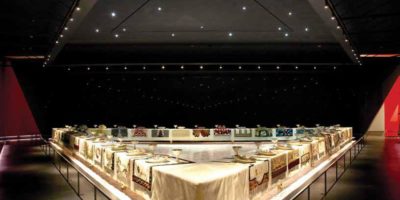Leaving Behind More Than a Trace
Chava Rosenfarb has long been considered one of our greatest Yiddish writers. Born in Lodz in 1923, she survived the Lodz ghetto, Auschwitz, the Sasel labor camp and then Bergen Belsen. Rosenfarb’s The Tree of Life, Book Two: From the Depths I Call You, 1940-1942 (University of Wisconsin Press, $21.95) is now available in English, translated from Yiddish by the author in collaboration with Goldie Morgentaler. Though it is the second of three volumes, each stands on its own.
The Tree of Life was written in Montreal, where Rosenfarb filled notebooks in the early hours before her children awakened. It is a realistic, fictionalized, account of life in the Lodz ghetto, where she and her family were trapped for four years, and focuses on the lives of 10 individuals.
As Rachel (perhaps Rosenfarb’s most autobiographical character) arrives in the ghetto, she wonders “whether there was a pair of All-Seeing Eyes somewhere, looking down from above and taking in the entire awesome spectacle.” Such a longrange view is impossible in the ghetto, where staying alive means struggling against poverty, death, disease, hunger, exhaustion, and the constant threat of annihilation by the Germans. Yet Rachel manages to attend classes and to organize a public library and a study group.
Beyond Rachel, we meet her sweetheart, David; the industrialist Samuel Zuckerman; the poet Simcha Bunim Berkovitch; and Chaim Rumkowski, the self-proclaimed “King of the Jews” and the novel’s only historical character. The lives whose stories Rosenfarb tells comprise a richly detailed portrait of an experience that most readers cannot imagine.
Rosenfarb’s work encompasses essays, poems, drama, short stories. For her novels, Bociany and Of Lodz and Love (both of which she translated herself), she received the John Glassco Prize in 2000—the first time this Canadian award was given to a work written originally in Yiddish. In 1971, when she received the J.J. Segal prize for The Tree of Life, the awards committee called Rosenfarb’s work “A miracle of continuity and creativity in the Yiddish language.” But Rosenfarb still speaks of her isolation “as a survivor — an isolation enhanced by my being a Yiddish writer… an anachronism wandering about a page of history on which I don’t belong.”
One of Rosenfarb’s characters in the Lodz ghetto remarks in The Tree of Life that “Words are the most helpless tools of the ghetto. The wordless language of the paintbrush, of the violin, reaches further than any words could. The ideal would be to leave behind masterpieces of silence, but this would be… nothing. And we fear nothingness. Everyone wants to leave a trace behind: a child, a painting, a letter.” We are fortunate that much of her work is now available in English, as what Rosenfarb has given us is more than just a trace.
Julia Wolf Mazow edited The Woman Who Lost Her Names: Selected Writings of American Jewish Women


